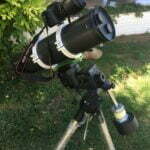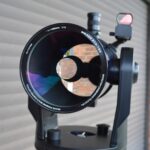Table of Contents
During my time as an astrophotographer, I have educated myself on the layout of the stars I regularly see above my head in the northern sky. I already had some experience with stargazing from my childhood, so this was a huge advantage. In astrophotography, we need to be able to identify the brightest stars in the night sky.
In this post, we will look at some of the brighter stars in the sky and discuss some of the features of these stars. There is quite a bit to know about them! For example, what’s the brightest star in the night sky? What’s the second-brightest star in the sky? I’ve got all the answers for you here.
But why, in astrophotography, should we be so concerned about the stars? One reason is that they can guide us to different areas in the sky near some very well-known and beautiful astronomy targets. In fact, before getting equipment that makes locating your chosen target simple and automatic, it is always a good idea to learn how to find objects the old-school way by moving from star to star.
Another reason why the bright stars in the sky matter to an astrophotographer is that we can use these stars to align our equipment and get perfect focus before we start imaging.
Let’s start our journey around the heavens and take each of the bright stars we can observe, one by one. Where possible, I’ll try to add any images I have taken of these stars.
Understanding Brightness: Exploring the Concept of Stellar Magnitude
Stellar magnitude is an astronomical measurement of how bright a star is. It is a logarithmic scale that assigns a numerical value to each star based on its apparent brightness as seen from Earth.
Hipparchus, an ancient Greek astronomer, created the scale in the second century BC, and astronomers have continued to use it in a modified form.
The magnitude scale is designed so that a difference of 5 magnitudes corresponds to a difference in brightness of 100 times. This means that a star with a magnitude of 1 is 100 times brighter than a star with a magnitude of 6.
There are two different measurements of magnitude: apparent magnitude and absolute magnitude. When determining a star’s apparent magnitude, observers on Earth take into account things like distance and how much light the atmosphere has absorbed. Absolute magnitude, on the other hand, measures the estimated brightness of a star, assuming it is located at a standard distance of 10 parsecs (about 32.6 light-years) from Earth. Absolute magnitude allows astronomers to compare the true brightness of stars, regardless of their distance from us.
What is the brightest star in the sky?
The brightest star in the sky is Sirius, also known as the Dog Star. Sirius is located in the constellation Canis Major and has an apparent magnitude of -1.46.
Sirius is visible through the winter months, and when it is in the sky, it becomes obvious that no other star can outshine it. Another reason why it appears so bright is because it stands against an area of the sky that is not so heavily populated with stars and is set away from Orion by some distance.
The universe is full of magical things, patiently waiting for our wits to grow sharper.
– Eden Phillpotts
What are the brightest stars in the night sky?
We’ve already mentioned the brightest star, Sirrius, so now let’s continue to list some of the others.
Here are a few of the stars I personally use regularly as I search the sky for my deep sky targets and which feature in my astrophotography setup and workflow.
First, I often use one of two stars to focus on. In the summer months, I tend to use Alkaid in the Big Dipper or Ursa Major because it is easy to find and quite high up in the sky to the northwest for many months. Now, in winter, I find myself pointing at the very bright star Vega, which is so easy to locate to the west and quite high up through the winter months.
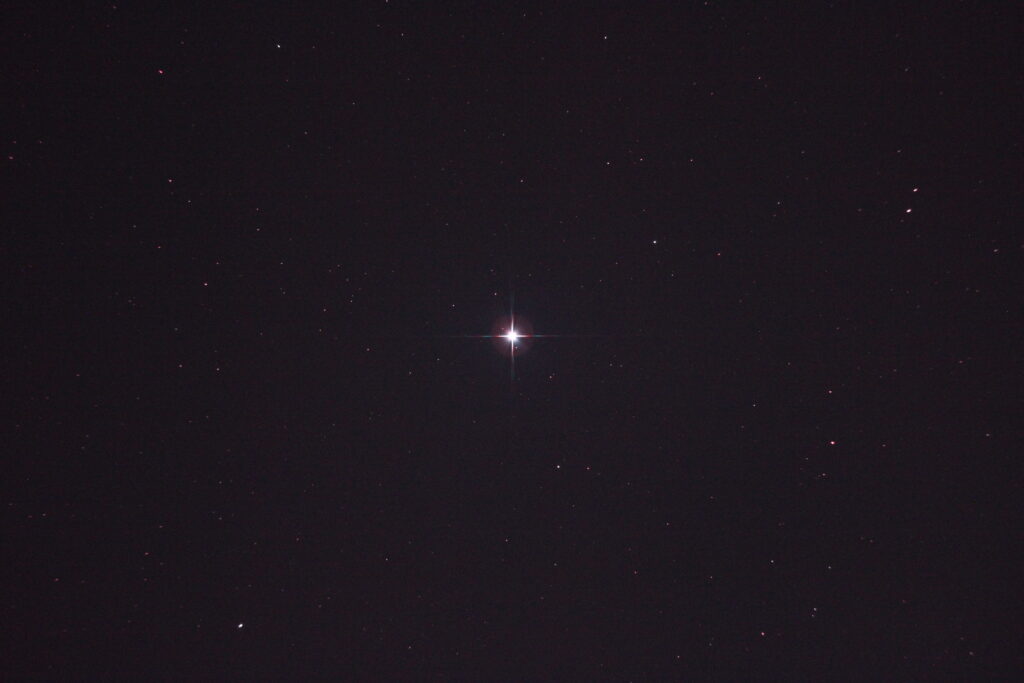
Above is a picture I took of Vega, just one shot with my Canon 600D DSLR. Exposure was just 20 seconds at ISO 1600 with a 50mm lens. It came out pretty well, I’d say!
In the deep winter, as I am so often imaging around the Orion Nebula region of the sky, I have learned to spot the orange flickering star of Betelgeuse, and this is a great star to use for navigation of this area of the sky and another ideal star to set up and check my focus at the start of a night’s astrophotography.
How can I identify what is the brightest star in the sky tonight?
I have touched on this above. The Orion constellation dominates the sky in winter and then disappears in summer. It is very easy to identify Betelgeuse as it is at the top of Orion above the three main stars and is orange in colour. It flickers a lot, which makes it even easier to spot. The reason for this flicker is because Betelgeuse is expected to go supernova in a massive explosion sometime in the “near” future. Or maybe it has already, because even if it happened right now, we wouldn’t see the explosion for 600 years due to its distance from us!
The pole star is more or less directly north and is always present in the northern hemisphere. You identify this star by looking to the north and up about 30–50 degrees, depending on your latitude. I can easily spot this one. It’s white but not very bright. All the other stars seem to revolve around this important resident of the night sky. You must identify it because you’ll need to align your telescope mount with the polar axis if you use an equatorial mount.
What are some tips for photographing stars in the night sky?
Here are a few things you’ll need to consider when photographing stars:
- How bright is the star? A star like Vega is so bright that when I shoot it for six seconds, it is overexposed. Therefore, lower your exposure time to a value that decreases as the star’s brightness increases.
- One shot will be enough to capture the star, but if your aim is to capture nebulosity around a star image, stack as normal.
- If you do use a filter in your camera, make sure to use an RGB filter to get good colour in your stars. Narrowband filters affect your star colours.
Are there any specific camera settings for astrophotography of stars?
No, just make sure you select an ISO of 800 or so if you use a DSLR and make the exposure short and a matter of just a few seconds.
Are there any apps or software that can help me locate stars in the night sky?
I use Sky Safari to locate bright stars in the sky. There are alternatives to this app, but this is the one I like to use.
One thing I advise any budding astrophotographer is to get a quality pair of binoculars as these are so useful in astronomy. With binoculars you can view the bright stars in all their glory and also use them to locate objects in the night sky. They are an important tool to take with you wherever you travel.
Here is a suggestion for a good quality pair of binoculars you can purchase online:
Do the stars have any significant cultural or historical importance?
Some of them do. Many believe that the three main stars of Orion formed the inspiration for the three pyramids at Giza, with their sizes reflecting the relative brightness of each star.
Pleiades, which consists of seven major stars in a cluster, have been seen throughout history and hold a special significance in history and culture.
The pole star was used for navigation for centuries or even thousands of years at sea and on land before technology enabled us to navigate more accurately. As the pole star is fixed in position (in our perspective), it has been used as a reference star throughout history.
Many stars in the night sky have cultural or historical importance. Let’s find out why.
Sirius: The Dazzling Jewel of the Winter Sky
One such star is Sirius, also called the Dog Star. In ancient Egypt, Sirius was highly revered, and its annual rise in the pre-dawn sky marked the beginning of the Nile flood, which was crucial for agriculture. The star’s brightness and association with the flooding of the Nile made it a significant symbol of rebirth and fertility in Egyptian mythology.
Vega: The Luminary of the Summer Triangle
Vega is the fifth brightest star in the night sky.
Vega, the most visible star in the constellation Lyra, is also culturally important. In many ancient civilizations, Vega was associated with love and romance. It is a prominent star in the mythologies of different cultures, including Greek, Chinese, and Native American. In Greek mythology, Vega is associated with the story of Orpheus and Eurydice, representing the lyre played by Orpheus.
Betelgeuse: The Fiery Red Giant in Orion’s Shoulder
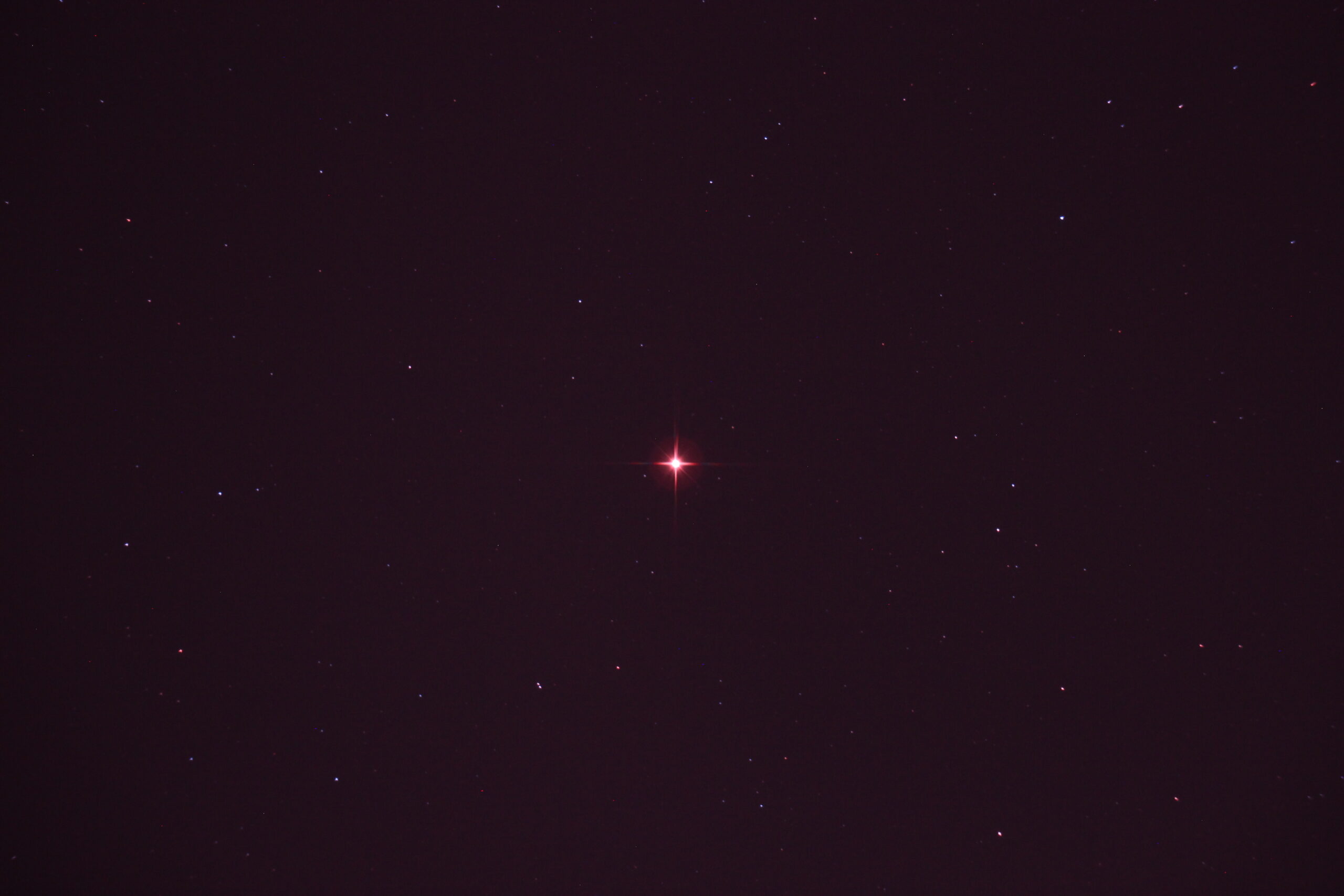
Betelgeuse, a bright red star in the constellation Orion, holds cultural significance as well. Its name is derived from the Arabic phrase meaning ‘the hand of Orion.’ Throughout history, various cultures have observed and made references to Betelgeuse. In Chinese astronomy, it is one of the Four Guardians of Heaven, representing the direction of the east. In ancient Arabian astronomy, Betelgeuse marked the shoulder of Orion and was associated with the mythical figure of the giant hunter.
The star does earn its reputation as a fiery red giant, as you can see from my image above, which was taken with a DSLR camera. It’s extremely red compared to other stars.
Rigel: The Blue Supergiant Illuminating Orion’s Foot
Rigel is the seventh brightest star in the night sky.
Rigel can be found in the constellation Orion. It is classified as a blue supergiant and is approximately 860 light-years away from Earth. It has an apparent magnitude of 0.18.
Rigel is a massive star, estimated to be around 23 times the mass of our Sun. Its high mass is one reason for its intense brightness, and this also means it will have a short life.
Rigel appears as a single point of light to the naked eye, but through a telescope, it can be resolved into a binary star system.
Rigel is not only visually striking but also an important star for astronomers. Its brightness and proximity make it a valuable reference point for calibrating other stars’ magnitudes. Additionally, studying Rigel provides insights into the evolution and characteristics of massive stars, which play a crucial role in shaping the universe.
For astrophotographers, capturing Rigel can be a rewarding experience. Its brightness and position in the constellation Orion make it a wonderful feature in many night sky photographs. Astrophotographers can capture absolutely stunning images of this magnificent star.
Aldebaran: The Fiery Eye of Taurus the Bull
Aldebaran, located in the constellation Taurus, has both cultural and historical importance. In ancient Mesopotamia, Aldebaran was considered one of the four royal stars, representing the season of spring. It was associated with the god Enlil and believed to bring good fortune. Aldebaran’s reddish appearance and its position as the eye of the bull in the constellation Taurus have made it a prominent star in various cultural and mythological contexts.
Canopus: The Brilliant Star of the Southern Hemisphere
Canopus is the second brightest star in the sky, after Sirius. It is located in the constellation Carina and can be seen from the southern hemisphere. Canopus is also visible from some parts of the northern hemisphere, but only near the horizon.
With an apparent magnitude of -0.72, Canopus can easily be seen with the naked eye. Its brightness is due to its large size and high luminosity.
Canopus is a yellow-white supergiant star, meaning it is much larger and brighter than an average star. It has a diameter that is approximately 71 times that of the sun and a mass that is about 8 to 9 times greater.
Canopus is estimated to be around 310 light-years from Earth. This makes it one of the closest bright stars to our solar system. Its proximity and brightness make Canopus a popular target for astrophotography enthusiasts.
When photographing Canopus, it is important to consider its location in the sky. As a southern star, it will be higher in the sky the further south you are. To capture its beauty, using a wide-angle lens and a tripod can help capture its brightness and the surrounding constellations.
Arcturus: A Beacon of Light in the Northern Skies
Arcturus is the fourth brightest star in the night sky.
Arcturus is a bright star located in the constellation Boötes, which is visible in the northern hemisphere during spring and summer.
Arcturus has a yellow-orange colour and is easily recognisable.
With a visual magnitude of -0.05, Arcturus can be easily seen even in light-polluted areas. It is about 25 times larger than the Sun and only 37 light-years away from Earth.
This star has been used as a reference point for astronomers to measure the motion of celestial objects and to determine the Earth’s motion through space.
Arcturus is also a part of various ancient cultures and mythologies, often associated with agricultural seasons and navigation.
Spica: The Sparkling Gem in the Constellation Virgo
Spica is very easy to recognise, in my opinion, and has a blue colour.
Spica is located about 250 light-years away from Earth and has a visual magnitude of approximately 0.97. If you do a search to find out if Spica is the brightest star in the sky, you’ll see that it is fifteenth in that list.
Spica is a spectroscopic binary. This means that changes in its spectral lines show that it is a binary system. This makes Spica an interesting target for astrophotography enthusiasts who want to capture the beauty of binary star systems.
Astronomers have been observing and studying Spica for centuries. It has served as a reference star for calibration purposes and has been used to measure the brightness and colour of other celestial objects. Its name, Spica, comes from the Latin word for ear of grain, as it represents an ear of wheat held by the constellation Virgo in ancient mythology.
To capture Spica in your astrophotography, you can use a DSLR camera with a telephoto lens or a telescope. It is recommended to use a stable tripod or mount to avoid any blurring or shaking during the long exposure. Adjust your camera settings to a higher ISO and a longer exposure time to capture the faint details of Spica. Experiment with different settings and techniques to achieve the desired result.
Pollux: The Heavenly Twin of the Gemini Constellation
I have come to spot the twin stars of Castor and Pollux, often low on the horizon. They are part of the constellation Gemini, which represents the twins in Greek mythology. Castor is not the brightest star in the sky, or in Gemini, the constellation; Pollux is. These stars are easily visible to the naked eye and can be found in the northern hemisphere. Their brightness and proximity to each other make them a popular target for astrophotography enthusiasts.
Castor is a multiple-star system, meaning it consists of multiple stars orbiting around a common centre of mass. It is composed of at least six stars, with the brightest being referred to as Castor A and Castor B. Castor A is a spectroscopic binary, which means it appears as a single star but actually consists of two stars orbiting each other. Castor B is also a binary star system.
Pollux, on the other hand, is a single star and the brightest in the constellation Gemini. It is an evolved giant star, much larger and brighter than our Sun. Pollux is also known for its orange-red colour, which adds a striking visual element to astrophotographs. Its brightness and distinct colour make it a captivating subject for astrophotography, especially when captured alongside Castor in the same frame.
Using a wide-angle lens or a telescope with a focal length suitable for capturing a larger field of view can help include more of the surrounding stars and constellations. Experimenting with different exposure times and ISO settings can also enhance the details and colours of these stars.
Regulus: The Regal Heart of the Lion in Leo
Regulus is a blue-white main-sequence star, meaning it is in the prime of its life and fusing hydrogen into helium in its core. It has a surface temperature of around 12,460 degrees Fahrenheit (6,900 degrees Celsius) and shines with an apparent magnitude of about 1.35, making it one of the top 25 most visible stars we see from Earth.
The name ‘Regulus’ comes from the Latin word for ‘little king’ or ‘prince’. It earned this name due to its association with the constellation Leo, which represents the Nemean lion in Greek mythology. Regulus is often referred to as the ‘Heart of the Lion’ because it marks the lion’s chest.
Regulus is located approximately 79 light-years away from Earth, making it one of the closest bright stars to our solar system. Despite its relatively close distance, Regulus appears as a single point of light to the naked eye, but through a telescope, it can be resolved into a binary star system. It has a companion star that is much dimmer and smaller than Regulus itself.
To photograph Regulus, you can use a DSLR camera with a telephoto lens or a dedicated astrophotography setup.
Antares: The Rival of Mars in the Scorpius Constellation
I love Antares because it is associated with a lot of nebulosity in the Rho Ophiuchus region. It’s a spectacular target to photograph and a major feature of our Milky Way galaxy. I’ve photographed it a couple of times and intend to return to it again now that I use an astronomy camera.
Antares is located in the constellation Scorpius. It is definitely one of the easiest to spot stars you can see in the night sky.
Antares is classified as a red supergiant, which means it is a massive star in the later stages of its life. It has a diameter that is approximately 700 times larger than our Sun.
The name Antares comes from the Greek words ‘anti’ and ‘ares’, which can be translated as ‘rival of Mars’. This name reflects its reddish appearance, similar to that of the planet Mars.
Its distinct red colour and brightness make it a popular target for photographers. Using a telescope or a camera with a telephoto lens, you can capture detailed images of Antares and its surrounding celestial objects.
Procyon: The Twin Star of Canis Minor
Procyon is the eighth brightest star in the night sky.
Procyon is located in the constellation Canis Minor, which means ‘the lesser dog’ in Latin. It is one of the brightest of stars, and its proximity to Earth makes it quite easy to capture in astrophotography images.
Procyon is a binary star system, meaning it consists of two stars orbiting around a common centre of mass. The primary star, Procyon A, is a yellow-white main-sequence star, similar in size and temperature to our Sun. The secondary star, Procyon B, is a white dwarf, a dense remnant of a star that has exhausted its nuclear fuel. The two stars orbit each other every 40.8 years.
Procyon is important in astronomy. Its name, Procyon, comes from the Greek word meaning ‘before the dog,’ as it rises just before the king of all the bright stars, Sirius, which is located in the constellation Canis Major. Astronomers have extensively studied Procyon, which has given them useful insights into binary star systems and stellar evolution.
Deneb: The Bright Star of the Cygnus Constellation
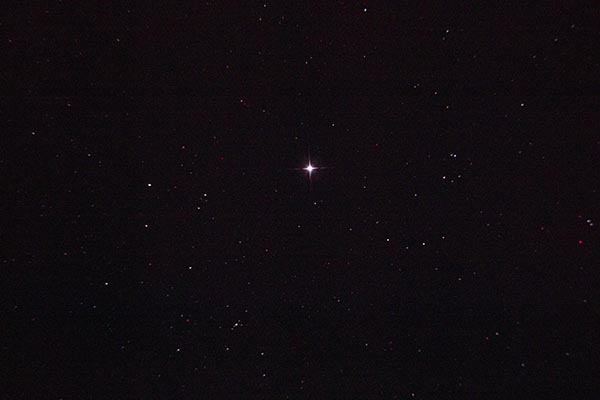
Above is an image I took of the star Deneb at 6 seconds of exposure with a Canon DSLR.
Deneb is found in the constellation Cygnus. It is a component of the Summer Triangle, an eye-catching asterism made up of three brilliant stars.
I’ve come across Deneb when locating and imaging regions like the North American Nebula, which is close by.
Deneb is classified as a blue-white supergiant; it is a massive and extremely bright star. It is estimated to be around 200,000 times brighter than our Sun and is one of the most distant stars visible to the naked eye, at a distance of about 1,550 light-years from Earth.
To photograph Deneb, you will need a camera, a sturdy tripod, and a wide-angle lens. Set your camera to manual mode and adjust the settings to a high ISO (e.g., 1600–3200) to capture the star’s brightness. Use a wide aperture (e.g., f/2.8 or lower) to gather as much light as possible. Experiment with different exposure times to avoid overexposing the star and maintain details in the surrounding sky.
I hope you enjoyed our brief look at some of the major stars that we can see in the night sky throughout the year. They are not only beautiful to look at, but they have magically inspired people for thousands of years all over the world.






